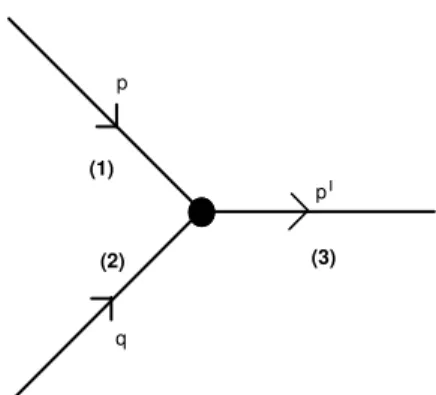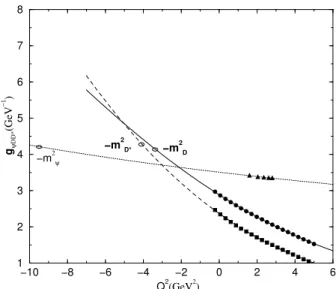236 Brazilian Journal of Physics, vol. 34, no. 1A, March, 2004
The
J/ψDD
∗
Vertex
R. Rodrigues da Silva, R.D. Matheus, F.S. Navarra, and M. Nielsen
Instituto de F´ısica, Universidade de S ˜ao Paulo, C.P. 66318, 05389-970 S ˜ao Paulo, SP, Brazil
Received on 15 August, 2003.
We employ QCD sum rules to calculate theJ/ψDD∗form factors and coupling constant by studying the three-pointJ/ψD∗Dcorrelation function. We find that the momentum dependence of the form factor depends on the off-shell meson. We get a value for the coupling which is in agreement with estimates based on constituent quark model.
Hadrons are composites of the underlying quarks whose effective fields describe point-like physics only when all the interacting particles are on mass-shell. When at least one of the particles in a vertex is off-shell, the finite size effects of the hadrons become important. Therefore, the knowledge of the form factors in hadronic vertices is of crucial impor-tance to estimate any hadronic amplitude using hadronic de-grees of freedom. This work is devoted to the study of the J/ψD∗D form factor, which is important, for instance, in
the evaluation of the dissociation cross section ofJ/ψ by pions and ρmesons using effective Lagrangians [1, 2, 3]. Since a decrease ofJ/ψproduction in heavy ions collisions might signal the formation of a quark-gluon plasma (QGP) [4], a precise evaluation of the background, i.e., conven-tional J/ψ absorption by co-moving pions andρ mesons, is of fundamental importance.
The J/ψD∗D coupling has been studied by some
au-thors using different approaches: vector meson dominance model plus relativistic potential model [1] and constituent quark meson model [5]. Unfortunately, the numerical re-sults from these calculations may differ by almost a factor two. The relevance of this difference can not be underesti-mated since the cross section is proportional to the square of the coupling constants. In ref. [3] it was shown that the use of different coupling constants and form factors can lead to cross sections that differ by more than one order of magni-tude, and that can even have a different behavior as a func-tion of√s.
In previous works we have used the QCD sum rules (QCDSR) to study theD∗Dπ[6, 7],DDρ[8] andJ/ψDD
[9] form factors, considering two different mesons off mass-shell. In these works the QCDSR results for the form fac-tors were parametrized by analytical forms such that the respective extrapolations to the off-shell meson poles pro-vided consistent values for the corresponding coupling con-stant. In this work we use the QCDSR approach to evaluate theJ/ψD∗Dform factors and use the same procedure
de-scribed above to estimate theJ/ψD∗Dcoupling constant.
The three-point function associated with aH1H2H3
ver-tex (see Fig. 1), whereH1andH3are the incoming and
out-going external mesons respectively and H2 is the off-shell
p
q
p (1)
(2) (3)
Figure 1. Diagram representing theH1(p)H2(q)H3(p′)vertex. meson, is given by
Γµν(p, p′) = Z
d4x d4y eip′.xe−i(p′−p).y
× h0|T{j3(x)j2†(y)j1†(0)}|0i, (1)
wherejiis the interpolating field forHi. ForJ/ψ,D∗and
D mesons the interpolating fields are respectively jµ(ψ) = ¯
cγµc,jν(D∗)= ¯qγνcandj(D)=i¯qγ5cwithqandcbeing a
light quark and the charm quark fields.
The phenomenological side of the vertex function, Γ(p, p′), is obtained by the consideration ofH
1andH3state
contribution to the matrix element in Eq. (1): Γ(phen)
µν (p, p′) = 1 p2−m2
1
1 p′2−m2
3
h0|j3|H3(p′)i
×hH3(p′)|j2†|H1(p)ihH1(p)|j1†|0i+h. r., (2)
where h. r. means higher resonances.
The matrix element of the currentj2 defines the vertex
functionVλλ′(p, p′):
hH3(p′)|j2†|H1(p)i=hH2(q)|j2†|0i
Vλλ′(p, p′) q2−m2
2
, (3)
whereq=p′−p. Callingp
1, p2andp3the four momentum
ofJ/ψ, D∗andDrespectively one has
Vλλ′(p1, p2, p3) =gψDD∗(q2)ǫαβγδǫλα(p1)ǫλ ′
R. Rodrigues da Silvaet al. 237
The vacuum to meson transition amplitudes appearing in Eqs. (2) and (3) are given in terms of the corresponding me-son decay constantsfHiby
h0|j(D)|Di=m
2
DfD
mc , (5)
and
hV(p, ǫ)|j†
α|0i=mVfVǫ∗α, (6) for the vector meson V = J/ψ or V = D∗. Therefore,
using Eqs. (3), (4), (5) and (6) in Eq. (2) we get Γ(phen)
µν (p, p′) = C
gψDD∗(q2)ǫαβµνpαp′β
(q2−m2
2)(p2−m21)(p′2−m23)
+ h. r., (7)
where
C= m
2
DmD∗mψfDfD∗fψ
mc . (8)
The contribution of higher resonances and continuum in Eq. (7) will be taken into account as usual in the standard form of ref. [10].
The QCD side, or theoretical side, of the vertex func-tion is evaluated by performing Wilson’s operator product
expansion (OPE) of the operator in Eq. (1). WritingΓµν in terms of the invariant amplitude:
Γµν(p, p′) = Λ(p2, p′2
, q2)ǫαβµνpαp′β
, (9)
we can write a double dispersion relation forΛ, over the virtualitiesp2andp′2
holdingQ2=−q2fixed:
Λ(p2, p′2, Q2) =
−4π12
Z
dsdu ρ(s, u, Q
2)
(s−p2)(u−p′2) ,
(10) where ρ(s, u, Q2) equals the double discontinuity of the
amplitude Λ(p2, p′2
, Q2) on the cuts smin ≤ s ≤ ∞,
m2
c ≤ u ≤ ∞, withsmin = 4m2c in the case of off-shell D∗ or D and smin = m2
c in the case of off-shell J/ψ. We consider diagrams up to dimension three which include the perturbative diagram and the quark condensate. To im-prove the matching between the two sides of the sum rules, we perform a double Borel transformation in both variables P2 = −p2 → M2 and P′2
= −p′2
→ M′2
We get one sum rule for each meson considered off-shell. Calling gM
ψDD∗(q
2)theψDD∗form factor for the off-shell meson
M, we get the following sum rules:
⌋
C g
(D)
ψDD∗(t) (t−m2
D) e−
m2D∗ M′2 e−
m2
ψ M2 = 1
4π2
Z s0
4m2
Z u0
umin
dsduρ(D)(u, s, t)e−Ms2e−Mu′2Θ(umax
−u), (11)
C g
(D∗) ψDD∗(t) (t−m2
D∗) e−
m2
D M′2e−
m2
ψ M2 = 1
4π2
Z s0
4m2
Z u0
umin
dsduρ(D∗)(u, s, t)e−Ms2e−
u
M′2Θ(umax
−u), (12)
and
C g
(J/ψ)
ψDD∗(t) (t−m2
ψ) e−
m2D M′2e−
m2D∗ M2 = 1
4π2
Z s0
m2
Z u0
umin
dsduρ(J/ψ)(u, s, t)e−Ms2e−
u
M′2Θ(umax
−u), (13)
⌈
witht=q2,
ρ(D)(u, s, t) =ρ(D∗)(u, s, t) = 3mc√
λ µ
1 + sλ2 λ
¶ , (14)
λ= (u+s−t)2−4us,λ
2=u+t−s+ 2m2c and
⌋ umax min = 1 2m2 c h
−st+m2
c(s+ 2t)± p
s(s−4m2
c)(t−m2c)2 i
, (15)
in the case of off-shellDorD∗. In the case of an off-shellJ/ψwe get:
ρ(J/ψ)(u, s, t) = 3mc λ3/2
£
(u−s)2−t(u+s−2m2c) ¤
−4π2<qq > δ(s¯ −m2c)δ(u−m2c), (16) and
umaxmin = 1 2m2
c h
−st+m2c(2s+t)± p
t(t−4m2
c)(s−m2c)2 i
. (17)
238 Brazilian Journal of Physics, vol. 34, no. 1A, March, 2004
In the Eqs. (11), (12) and (13) we have transferred to the QCD side the higher resonances contributions through the introduction of the continuum thresholdss0andu0.
5 6 7 8 9 10 11
0.5 1.5 2.5 3.5
M2 Q2=−0.21GeV2
Q2=5GeV2
gψ
DD*
(GeV
−1 )
(GeV2)
Figure 2. M2 dependence of gJ/ψDD(D) ∗(Q 2)
for Q2 =
−0.21GeV2andQ2= 5.0GeV2.
The parameter values used in all calculations aremc = 1.3 GeV, mD = 1.87GeV, mD∗ = 2.01GeV, mψ = 3.1 GeV,fD= (170±10) MeV,fD∗ = (240±20) MeV, fJ/ψ = (405±15)MeV, hqqi = −(0.23)3GeV3
. The continuum thresholds for the sum rules ares0= (m1+∆s)2
andu0= (m3+ ∆u)2with∆s= ∆u= 0.5GeV.
We first discuss theJ/ψDD∗ form factor with an
off-shell D meson. In Fig. 2 we show the behavior of the form factor gJ/ψDD(D) ∗(Q
2) atQ2 = 5.0GeV2
andQ2 =
−0.21 GeV2, as a function of the Borel mass M2 using
M′2 = M2m2
D∗ m2
ψ
. We can see that the QCDSR results are rather stable in the interval7≤M2 ≤11GeV2
. In Fig. 3 we showg(J/ψDDD) ∗(Q
2=−0.21GeV2)
as a function ofM2
andM′2.
Figure 3. M2 and M′2 dependence of g(D)
ψDD∗(Q 2 =
−0.21GeV2).
From Fig. 3 we see that the stability is still good even considering the two independent Borel parameters. The same kind of stability is obtained for other values ofQ2and
for the other two form factors. FixingM2 = m2
1andM′ 2
= m2
3we show, in Fig. 4,
the momentum dependence of the QCDSR results for the
form factorsg(ψDDD) ∗, g (D∗) ψDD∗ and g
(J/ψ)
ψDD∗ through the cir-cles, squares and triangles respectively. Since the present approach cannot be used atQ2<<0, to extract thegψDD
∗ coupling from the form factors we need to extrapolate the curve toQ2=−m2
2: the mass of the off-shell meson.
−10 −8 −6 −4 −2 0 2 4 6
Q2(GeV2) 1
2 3 4 5 6 7 8
−m2ψ
gψ
DD*
(GeV
−1 )
−m2D
−m2D*
Figure 4. Momentum dependence of theJ/ψDD∗form factors. The dotted, dashed and solid lines give the parameterization of the QCDSR results (triangles, squares and circles) through Eqs. (18), (19) and (20) respectively.
In order to do this extrapolation we fit the QCDSR sults with an analytical expression. We tried to fit our re-sults with a mono-pole form, since this is very often used for form factors, but the fit was only good forgψDD(J/ψ)∗. For g(ψDDD) ∗ andg
(D∗)
ψDD∗ we obtained good fits using a Gaussian form. We get:
g(ψDDJ/ψ)∗(Q
2) = 199.2
Q2+ 56.8, (18)
gψDD(D∗)∗(Q
2) = 19.9exp
·
−(Q
2+ 27)2
345 ¸
, (19)
g(ψDDD) ∗(Q
2) = 12.7
exp ·
−(Q
2+ 25.8)2
450 ¸
. (20)
These fits are also shown in Fig. 4 through the dotted, dashed and solid lines respectively. From Fig. 4 we see that all three form factors lead to compatible values for the coupling con-stant when the form factors are extrapolated to the off-shell meson mass (shown as open circles in Fig. 4). Considering the uncertainties in the continuum threshold, and the differ-ence in the values of the coupling constants extracted when theD,D∗ or J/ψmesons are off-shell, our result for the
J/ψDD∗coupling constant is:
R. Rodrigues da Silvaet al. 239
Table I: Values of the coupling constantgψDD∗in GeV−1
evaluated using different approaches.
this work ref. [1] ref. [5] 3.48±0.76 8.02±0.62 4.05±0.25
While our result is compatible with the coupling ob-tained using constituent quark meson model [5], it is half of the value obtained with the vector meson dominance model plus relativistic potential model [1].
To summarize: we have used the method of QCD sum rules to compute form factors and coupling constant in the J/ψDD∗ vertex. Our results for the coupling show once
more that this method is robust, yielding numbers which are approximately the same regardless of which particle we choose to be off-shell and depending weakly on the choice of the continuum threshold. As for the form factors, we ob-tain a harder form factor when the off-shell particle isJ/ψ, when compared with the form factors obtained when the off-shell particles areDorD∗.
Acknowledgments
This work was supported by CNPq and FAPESP.
References
[1] Y. Oh, T. Song and S.H. Lee, Phys. Rev. C63, 034901 (2001); Y. Oh, T. Song, S.H. Lee and C.-Y. Wong, nucl-th/0205065.
[2] F.S. Navarra, M. Nielsen, and M.R. Robilotta, Phys. Rev. C64, 021901 (R) (2001).
[3] K.L. Haglin and C. Gale, hep-ph/0305174.
[4] T. Matsui and H. Satz, Phys. Lett. B178, 416 (1986).
[5] A. Deandrea, G. Nardulli and D. Polosa, hep-ph0302273.
[6] F.S. Navarra, M. Nielsen, M.E. Bracco, M. Chiapparini, and C.L. Schat, Phys. Lett. B489, 319 (2000).
[7] F.S. Navarra, M. Nielsen, and M.E. Bracco, Phys. Rev. D65, 037502 (2002).
[8] R.D. Matheus, F.S. Navarra, M. Nielsen, and R. Rodrigues da Silva, Phys. Lett. B541, 265 (2002).
[9] M.E. Bracco, M. Chiapparini, A. Lozea, F.S. Navarra, and M. Nielsen, Phys. Lett. B521, 1 (2001).


